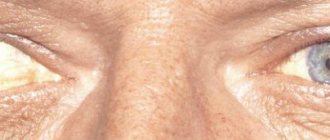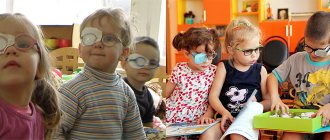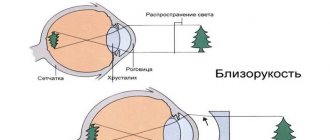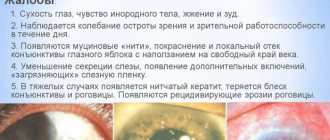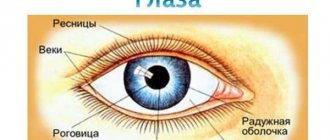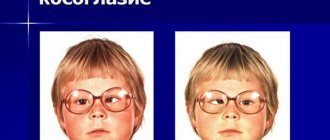Pleoptics belongs to one of the branches of ophthalmology.
Using the technique, pathological eye conditions such as strabismus or amblyopia are eliminated.
The disease develops due to difficulty processing and receiving information from the organ of vision to the brain. Young children are susceptible to the pathology, but there are cases of its development in adults. Amblyopia can be cured using pleoptics only after eliminating the factors that provoke the disease.
The main goal of pleoptics is to stimulate the retina of the visual apparatus and normalize the transmission of information from the organ of vision to the brain. Pleoptic treatment can eliminate strabismus in a patient. The main methods of pleoptic therapy are:
Occlusion
The technique involves applying an opaque material to the organ of vision without amblyopia. Thus, the healthy eye is switched off. It is possible to use a special correction device, for example glasses with occluders placed in them. The device is attached to the glass of the correction device. The time period of occlusion depends on the doctor’s instructions and the patient’s level of vision.
The need to constantly wear a correction device is indicated only for strabismus. In the case of amblyopia, the correction agent is applied several hours a day. Therapy lasts from six months to 2 years. It is worth remembering that occlusion can disrupt binocular vision, so a transition to other pleoptic techniques is necessary.
Diagnosis of amblyopia
The earlier eye amblyopia is detected, the higher the chance of getting rid of it. The effectiveness of treatment depends on timely diagnosis, the experience of specialists, and the prescription of correct treatment. It is possible to completely restore vision using modern equipment and the right approach.
The disease is diagnosed using a comprehensive examination. If you have the slightest visual impairment, you should immediately contact a professional clinic. Amblyopia is diagnosed as follows:
- Initial eye examination. The doctor looks at the eyelids, pays attention to the gap, the apple, and determines the reaction of the pupil to light. Listens to the patient's complaints and suggests further examination methods.
- Special tests are carried out to determine visual acuity, color perception, and perimetry. In this way, the severity of amblyopia is determined.
- An ophthalmoscopy is performed to determine abnormalities in the eye.
- Biomicroscopy is performed.
- If it is impossible to determine the extent of the damage, an ultrasound of the eye is prescribed.
- If necessary, the level of strabismus according to Hirschberg is determined.
A comprehensive examination often includes tonometry and electroretinography. The doctor can also collect a number of tests for a general examination of the body and determine the nature of the disease. As an additional study, the following are prescribed:
- visometry;
- pachymetry;
- ultrasound biometrics;
- refractometry;
- skiascopy;
- computer keratotopography.
All these procedures make it possible to accurately determine visual impairment and prescribe the correct treatment package. It is also important to identify retinal problems and prevent the development of blindness. At our medical center, specialists will help improve vision and maintain health.
Stimulation of the retina of the visual apparatus by physical influence
Stimulation is carried out through physical impact on the patient’s visual apparatus. Depending on the readings, heat, light pulses or ultraviolet rays are indicated. The procedure can be performed at home, but only after consulting an ophthalmologist. To stimulate the retina:
Laser stimulation
Using a low-intensity laser, the visual apparatus is stimulated, which increases blood circulation in this area. Exposure to laser radiation contributes to:
- improvement of microstimulation of the visual apparatus;
- increasing metabolism in the area of the visual organs;
- increased enzymatic activity;
- normalization of trophic reactions;
- optimization of fiber energy resources.
Irradiation is carried out with two types of radiation, namely red and infrared. To implement the technique, neon, argon and helium-neon lasers are used. Particularly common laser models are:
- Amblyospekl RL-1;
- LAST-1;
- Ufa;
- Neuron.
Ophthalmologists note some disadvantages of retinal stimulation using laser therapy:
- not the natural origin of the beam;
- high intensity of luminous flux;
- the likelihood of retinal trauma due to radiation.
Light stimulation
Amblyopia is treated with light stimulation of the retina. The following devices are used for this:
- ASO-1. The device creates rhythmic light waves that stimulate the visual organs. The device is equipped with a spectacle frame. It is necessary for color therapy and biorhythm therapy. Inside the device there are light bulbs with a light filter. Color therapy is based on the colors red, green and blue.
- KEM-CT. The device belongs to macular stimulators. Activates all levels of the visual system through stimulation of frequency-contrast stimuli. According to statistics, about 61% of patients note a significant improvement in image quality after undergoing a course of therapy using CEM-CT.
- PS-1. The device produces a concentrated light flux, which is supplied through a narrow range, which significantly increases the intensity of stimulation of the visual organs.
- Mosaic PS-2. The apparatus consists of a mosaic and a pipe. The design resembles a kaleidoscope. The equipment stimulates the retina using the play of light and shadow.
Electrical stimulation
Amblyopia is treated using electrical stimulation under the influence of low-intensity electrical impulses. The current stimulates neuromuscular tension and the sensory apparatus of the visual organ. After the procedure, the following is observed:
- increased blood circulation in the area of the visual organs;
- improvement of metabolism;
- activation of trophic processes;
- restoration of reflexes;
- improving picture quality;
- the level of retinal sensitivity to external stimuli increases;
- the field of view expands;
- the scale of absolute scotomas decreases and relative blind areas disappear;
- accommodation increases.
Several types of pulses are used:
- pointed;
- exponential;
- rectangular.
The selection of the required intensity and duration of the procedure is determined by the ophthalmologist.
Phosphen stimulation
Stimulation is carried out using a weak current passing through the eyelids. The Phosphen apparatus is used for manipulation. The design stimulates the retina and accommodation. The therapy helps strengthen the oculomotor muscle fibers. The procedure is carried out using devices:
- phosphene-1;
- phosphene-2;
- AiNUR-03;
- phosphene mini.
To obtain the effect, electrical stimulators are applied to the eyelids, which emit a current of a certain intensity.
Electromagnetic stimulation
The magnetic field is one of the safest methods of stimulating the retina. To treat a disease, several types of fields are required:
- impulsive;
- variables;
- permanent.
Magnet therapy has a beneficial effect on the general condition of the visual system due to:
- increasing blood flow;
- improving local metabolism;
- increasing the size of capillaries;
- restoration of trophic processes.
The following equipment is used to carry out the procedure:
- light-magnetic apparatus MS-4;
- electromagnetic stimulator ATOS;
- color magnetic device TsMS-11;
- stimulator BIO-MAX.
Patients tolerate the procedure easily. Manipulation cannot provoke complications of the visual system disease. Once certain skills have been mastered, the patient can independently undergo therapy at home.
Reflexology
The method consists of stimulating acupuncture sites with various irritants. The procedure for exercising influence is:
- massage;
- thermal irritants;
- electromagnetic;
- infrared rays.
A striking example of reflexology is acupuncture. Acupuncture points are irritated, which normalizes the processes of inhibition and excitation in the brain. The following devices are also used to carry out the course of therapy:
- phospheneelectropuncture;
- Mole apparatus.
Vibration stimulation
Vibration massage belongs to physiotherapeutic techniques. To carry out therapy, a vibration therapy device is used, designed to stimulate the visual organs. To carry out the manipulation, a special device is placed on the patient’s eyelids, which produces mechanical vibrations. The process stimulates the retina of the eyes.
Risk factors
Genetic aspects - if one of the parents has strabismus, anisometropia, amblyopia, then the likelihood of its development in the child increases.
Causes
- Congenital refractive errors (optics of the eye): hypermetropia, myopia, astigmatism.
- Anisometropia is the difference in refraction and visual acuity between the eyes;
- Strabismus, nystagmus, albinism;
- Congenital cataract (clouding of the lens);
- Cloudiness of the cornea (cataract);
- Ptosis (drooping) of the upper eyelid.
Types of amblyopia
- Refractive
– low vision due to a blurred image on the retina due to refractive errors; - Anisometropic
- low vision due to optical differences between the eyes (anisometropia). - Dysbinocular
- low vision as a result of strabismus, when the deviated eye does not take part in the visual process, and binocular vision is absent; - Deprivation
(obscuration) - low vision in the absence of light access to the retina with congenital opacities of the cornea, lens, drooping upper eyelid, etc.; - Hysterical
(psychogenic blindness) - temporary loss of vision during hysteria, often in combination with other functional disorders of the visual analyzer (impaired color perception, narrowing of visual fields, photophobia, etc.)
Amblyopia can be unilateral or bilateral, and also varies in severity - from a slight decrease in vision to light perception.
Therefore, depending on the decrease in vision, there are:
- low degree of amblyopia - with visual acuity 0.8-0.4 (80-40%);
- medium degree - at 0.3-0.2 (30-20%);
- high - at 0.1-0.05 (10-5%);
- very high - at 0.04 and below (less than 4%).
Computer methods of pleoptics
The pleoptic technique is carried out using computer technology. For this purpose, various programs for adults are used, and special games have been developed for children. The system contains types of games intended for children, namely:
- "Tiger" or "Pursuit". While looking at the monitor, stimulation of the retina is caused by objects becoming smaller and larger. During therapy, an increase in visual acuity and normalization of retinal function are observed.
- "Cross" The playing field is presented in the form of a chessboard. During therapy, cells change their size characteristics. At some stages of the game, color stimulation also occurs, since the game changes the hue on the playing field.
- "Spider." The screen displays radial and spiral types of gratings. Dynamic animations help activate accommodation and central vision.
- "Relief". The game is used for pediatric patients to eliminate amblyopia with correct fixation. During the procedure, various figures with differences in shadows and light are presented on the monitor.
- "Contour". The goal of the game is to train the muscle fibers of the organ of vision. The patient is shown figures that he must draw with his lazy eye.
- "Flower". In the center of the monitor there is a flower with various images on its petals. There is a picture in the middle of the flower. The patient's goal is to point out identical images on the petals and in the middle of the flower.
- "Amblyocor". The program is designed to eliminate the complicated course of amblyopia and congenital forms of the disease. After undergoing therapy, the development of reflex mechanisms of the brain is observed, which makes it possible to restore the distorted image of the retina of the visual apparatus. Ophthalmologists recommend treatment for patients who have exceeded 4 years of age.
Computer-assisted retinal stimulation techniques facilitate the treatment of amblyopia in young children. During the procedure, there is no stress for the child, since stimulation is presented in the form of a game.
Indications for the treatment of amblyopia
The worst decision with this diagnosis is to ignore it. In the future, it will be almost impossible to correct vision defects. Therefore, when a pathology is detected, the disease should be eliminated immediately. Indications for treatment of amblyopia are:
symptoms appear that indicate the presence of pathology;
- the child complains of discomfort, pain;
- the child cannot concentrate on an object, accurately describe its color, shape, details;
- headaches and severe fatigue occur;
- eyes squint periodically;
- loss of vision.
All this indicates that you need to contact a specialist who will help you understand what the problems are and prescribe a set of procedures to restore your vision. The clinic of JSC "Medicine" offers a full complex. Patients with amblyopia restore their level of vision to the maximum and get rid of pathologies.
What contraindications does amblyopia have during treatment?
Sometimes not all methods are suitable for use. Difficulties may arise in treating the disease, since there are a number of factors that impede the implementation of comprehensive measures. Let's figure out what contraindications amblyopia has, and under what conditions its elimination is not carried out:
- carrying out any manipulations in case of illness is prohibited in complex forms of organ dysfunction;
- the individual characteristics of the body may not allow a set of therapeutic measures to be carried out;
- late contact with a specialist leads to the fact that the doctor may simply refuse to eliminate the pathology;
- too much mechanical damage to the organ;
- blindness occurs, in which it makes no sense to provide medicinal effects.
In such cases, the doctor will not be able to help or will be forced to choose other methods of influencing the organ. You can learn more about this at an appointment with a specialist.
Useful video
Regardless of the type of pleoptic treatment, it is necessary to follow the course prescribed by the ophthalmologist. Untimely treatment of amblyopia will lead to a decrease in visual acuity. It is much easier to eliminate the disease in childhood than in adulthood. It is worth noting that patients experience cases of relapse of the disease. On average, it is necessary to undergo about 4 courses of pleoptics per year to consolidate the results of therapy.
Author's rating
Author of the article
Alexandrova O.M.
Articles written
2031
about the author
Was the article helpful?
Rate the material on a five-point scale!
If you have any questions or want to share your opinion or experience, write a comment below.
